#On-Demand Clone App
Explore tagged Tumblr posts
Text
The Gojek Clone is a Game Changer for Entrepreneurs in the Multi-Service App Market

The proliferation of smartphones and the rise of the gig economy have revolutionized the way services are accessed and delivered, giving birth to the on-demand service industry. In this dynamic landscape, multi-service apps have emerged as a popular and convenient solution for consumers seeking a wide range of services at their fingertips.
This article explores the game-changing potential of the Gojek Clone, a versatile platform that empowers entrepreneurs to tap into the multi-service app market and revolutionize the way services are offered and consumed.
Introduction to the Multi-Service App Market
Overview of the On-Demand Service Industry
The on-demand service industry is like your personal genie in a bottle, granting your wishes for food delivery, ride-hailing, beauty services, and more at the tap of a screen. It's the ultimate convenience for our busy, modern lives.
Understanding the Gojek Clone Concept
Definition and Origin of Gojek Clone
A Gojek clone is basically the cool, identical twin of the popular multi-service app Gojek. It's like copying your best friend's homework, but in the business world. The clone replicates the core features and functionalities of Gojek, allowing entrepreneurs to start their own multi-service app without reinventing the wheel.
How Gojek Clone Works
Just like a fast-food drive-thru, a Gojek clone simplifies the process of launching a multi-service app. You get a ready-made solution that can be customized to suit your brand and target audience. It's the plug-and-play of the app development world.
Key Features and Functionality of a Gojek Clone
Core Features of a Multi-Service App
Think of a multi-service app like a Swiss Army knife – it's got a little something for everyone. Features such as user profiles, service categories, real-time tracking, payment integration, ratings & reviews, and more are the backbone of a successful multi-service platform.
Customization Options for Gojek Clone
Want to add a sprinkle of your brand's personality to your Gojek clone? No problem! From color schemes and logos to service offerings and pricing structures, you can customize your clone to stand out in the crowded app market. It's like putting your own twist on a classic recipe.
Benefits of Using a Gojek Clone for Entrepreneurs
Cost-Effectiveness and Time-Saving
Launching a multi-service app from scratch can be like trying to build a spaceship in your backyard – costly and time-consuming. With a Gojek clone, you save both money and time, getting your app off the ground faster and without breaking the bank. It's the entrepreneurial equivalent of finding a shortcut on your morning commute.
Scalability and Business Expansion
Dreaming of taking over the world with your multi-service app empire? A Gojek clone sets you up for success by offering scalability and flexibility. As your business grows, you can easily add new services, expand into new markets, and conquer new horizons. It's like having a magic beanstalk that leads straight to the land of success.
Challenges and Considerations for Implementing a Gojek Clone
Regulatory and Legal Issues
When diving into the multi-service app market with a Gojek clone, entrepreneurs need to navigate a labyrinth of regulatory and legal hurdles. From licenses for different services to data protection laws, ensuring compliance is crucial. Don't let red tape trip you up!
Competition and Market Saturation
With the buzz around multi-service apps growing louder, standing out in a sea of competition can feel like a Herculean task. Building a unique value proposition and honing in on a specific niche is key to avoid drowning in a sea of copycats.
Success Stories of Entrepreneurs in the Multi-Service App Market
Inspirational Cases of Gojek Clone Adoption
From garage startups to tech titans, there are inspiring tales of entrepreneurs who've harnessed the power of Gojek clones to revolutionize the multi-service app market. These stories serve as beacons of hope for those embarking on a similar journey.
Leveraging Gojek Clone for Business Growth
Smart entrepreneurs know that simply having a Gojek clone isn't enough – it's all about how you wield it. By strategically leveraging the features and capabilities of the clone, businesses can scale, diversify, and carve out their own success stories in the market.
Future Trends and Opportunities in the Multi-Service App Market
Technological Advancements and Innovations
The only constant in the tech world is change, and the multi-service app market is no exception. Keeping an eye on emerging technologies like AI, IoT, and blockchain can provide a competitive edge and unlock new possibilities for innovation.
Emerging Markets and Untapped Niches
While major cities have seen the multi-service app fever reach a boiling point, untapped markets and niche segments present exciting opportunities for growth. By thinking outside the urban bubble and exploring new frontiers, entrepreneurs can unearth hidden gems waiting to be discovered.
Conclusion
The Gojek Clone presents a myriad of opportunities for entrepreneurs looking to make a mark in the multi-service app market. With its innovative features, scalability, and potential for business growth, this game-changing platform is set to redefine the way services are accessed and delivered. By embracing the Gojek Clone app script concept, entrepreneurs can position themselves at the forefront of the on-demand service industry and pave the way for success in the evolving digital economy.
FAQ
1. What is a Gojek Clone?
A Gojek Clone is a ready-made solution that replicates the features and functionalities of the popular multi-service app Gojek. It allows entrepreneurs to launch their own on-demand service platform quickly and cost-effectively.
2. How can entrepreneurs benefit from using a Gojek Clone?
Entrepreneurs can benefit from using a Gojek Clone by gaining access to a comprehensive set of features for offering multiple services on a single platform. This can help streamline operations, attract a wider customer base, and drive business growth.
3. Are there any challenges associated with implementing a Gojek Clone?
While implementing a Gojek Clone can offer numerous benefits, entrepreneurs may face challenges such as regulatory hurdles, competition in the market, and the need for continuous innovation to stay ahead in the dynamic multi-service app industry.
4. What are the future trends and opportunities in the multi-service app market?
The multi-service app market is constantly evolving, with trends such as AI integration, personalized services, and sustainability gaining prominence. Entrepreneurs can seize opportunities by leveraging these trends to enhance user experience and stay competitive in the market.
#gojek clone app script#gojek clone script#on-demand clone app#gojek clone multi-service app#gojek clone app development#white-label gojek clone app development services
0 notes
Text
1 note
·
View note
Text
How can an Uber clone app be customized to fit different business models?
An Uber clone app can be tailored to fit various business models, allowing entrepreneurs to adapt the core functionalities of the popular ride-hailing service to meet specific market demands. Here are several ways an Uber clone app can be customized:
1. Branding and User Interface Customization
The visual identity of your app is crucial for attracting users. An Uber clone app can be customized with unique branding elements, including logos, color schemes, and design layouts that reflect your business's identity. This personalization helps create a distinct presence in the competitive ride-sharing market, making it easier for customers to recognize and trust your service.
2. Feature Integration Based on Business Needs
Different businesses may require specific features that cater to their target audience. For instance:
Ride-Sharing Options: If your business model focuses on carpooling or ride-sharing, you can integrate features that allow users to share rides and split fares.
Delivery Services: Some entrepreneurs may want to expand their services beyond transportation to include food delivery or package delivery options, which can also be accommodated within the app.
Dynamic Pricing Models: Depending on demand and supply, implementing dynamic pricing can help maximize revenue during peak hours while remaining competitive during off-peak times.
3. Payment Gateway Customization
The payment process is a critical aspect of any ride-hailing service. An Uber clone app allows you to integrate multiple payment gateways tailored to your target market's preferences. This could include local payment methods, digital wallets, credit/debit cards, and cash options, ensuring convenience for all users.
4. Geographical Adaptation
To succeed in different regions, an Uber clone app can be customized to comply with local regulations and cultural preferences. This includes adapting the app's functionalities to meet regional traffic laws, fare structures, and user expectations. Such localization enhances user experience and builds trust within specific communities.
5. Scalability Features
As your business grows, so should your app's capabilities. An Uber clone app is designed to scale seamlessly with your operations. You can add new features, accommodate more users and drivers, and expand service areas without significant modifications to the existing infrastructure . This scalability ensures that your business can adapt quickly to changing market conditions.
6. Admin Dashboard Customization
A robust admin dashboard is essential for managing operations effectively. Customizing this feature allows you to monitor key performance indicators (KPIs), manage driver profiles, track user activity, and analyze revenue streams in real-time. This data-driven approach helps in making informed decisions that drive growth.
Conclusion
Customizing an Uber clone app is not just about replicating existing functionalities; it’s about creating a unique platform that aligns with your specific business model and market needs. From branding and feature integration to payment solutions and scalability, the flexibility of an Uber clone app provides entrepreneurs with the tools they need to succeed in the competitive ride-sharing landscape. By leveraging these customization options effectively, businesses can enhance user experience and establish a strong foothold in their respective markets.
1 note
·
View note
Text

Building Your Own Instacart: The Ultimate Comprehensive Guide
Looking to develop a cutting-edge Instacart- like app? Stand out with features like seamless user registration, profile management, real-time order tracking, diverse payment options (Stripe, PayPal, Braintree), and a robust review system. Build using React Native, Flutter, or Angular for the front end, and Node.js, Python, or Ruby on Rails for the backend. Real-time tracking powered by Google Maps API or Mapbox ensures a superior user experience. For detailed insights and cost breakdown, visit our blog or website.
0 notes
Text
🚀 Launch Your Multi-Service App in 5 Days | Gojek Clone Demo!
Ready to dominate the on-demand market? Fox-Jek lets you launch a fully functional multi-service app like Gojek – covering taxi rides, food delivery, handyman services, grocery delivery, and more – all within a single platform! 💼
👉 Live demo available now!
🔑 100+ services in one app
💡 White-label solutions for startups
🎯 Fast deployment and full customization
1 note
·
View note
Text
#Blinkit app development#Swiggy Instamart app development#Zepto app development services#Grocery delivery app development#On-demand delivery app development#Custom Blinkit-like app solutions#Zepto clone app development#Swiggy Instamart clone development
0 notes
Text
Why Your Startup Needs an On-Demand Clone App Solution?
An on-demand clone app solution can help startups quickly enter competitive markets by offering pre-built, customizable features suited to their specific needs. This blog covers how clone apps save time and resources, allowing startups to reach customers faster while providing reliable, user-friendly platforms. By choosing a clone app, startups can focus on growth and service quality without building an app entirely from scratch.
0 notes
Text

Explore the eight key benefits of on-demand apps that can revolutionize your business and improve customer satisfaction, boosting efficiency and offering instant convenience. For more details, check out our infographics!
0 notes
Text
Gojek Clone Script: Your Pathway to a Multi-Service App Revolution

In today's fast-paced digital era, the concept of multi-service apps has revolutionized the way we access various on-demand services. One of the leading platforms in this space is Gojek, a super app that offers a wide range of services from transportation and food delivery to payment solutions and more.
For entrepreneurs looking to tap into this burgeoning market, Gojek clone scripts present a compelling pathway to creating their own multi-service app. This article delves into the world of Gojek clone scripts, exploring their benefits, key features, implementation strategies, challenges, and future trends within the on-demand service industry.
Introduction to Gojek Clone Scripts
What is a Gojek Clone Script?
Imagine taking the concept of Gojek, a super app that offers multiple services like ride-hailing, food delivery, and more, and creating your own version of it. That's essentially what a Gojek Clone Script is - a ready-made solution that lets you launch a similar multi-service app tailored to your needs.
Evolution of Multi-Service Apps
Multi-service apps have come a long way from just offering a single service. With the rise of technology and consumer demand for convenience, apps like Gojek have revolutionized how we access various services seamlessly in one place.
Understanding the Multi-Service App Revolution
Rise of On-Demand Service Platforms
On-demand service platforms have changed the game by providing instant access to services like transportation, food delivery, beauty services, and more at the tap of a button. This shift has transformed the way we interact with services, making convenience a top priority.
Impact on Consumer Behavior
The convenience and efficiency of multi-service apps have significantly impacted consumer behavior. People now expect quick access to a variety of services through a single platform, leading to a surge in demand for all-in-one solutions like Gojek.
Benefits of Using a Gojek Clone Script
Cost-Effectiveness and Time-Saving
By using a Gojek Clone Script, you can save time and money on developing a multi-service app from scratch. The ready-made solution provides a cost-effective way to enter the market quickly and start offering a range of services to your customers.
Scalability and Customization Options
One of the significant advantages of a Gojek Clone Script is its scalability and flexibility. You can easily customize the app to suit your brand identity and scale it as your business grows, ensuring that your app remains relevant and competitive in the market.
Key Features of a Gojek Clone Script
User-Friendly Interface
A user-friendly interface is crucial for the success of any app, especially a multi-service platform like a Gojek Clone. The script should offer an intuitive design that makes it easy for users to navigate through different services and complete transactions seamlessly.
Multi-Service Integration
The heart of a Gojek Clone Script lies in its ability to integrate multiple services seamlessly. From ride-hailing to food delivery to grocery shopping, the app should provide a smooth experience for users to access and utilize various services within a single platform.
How to Implement a Gojek Clone Script Successfully
Market Research and Analysis
Before diving into the development process, it is crucial to conduct thorough market research and analysis. Understand your target audience, competition, and market trends. This will help you tailor your Gojek clone script to meet the specific needs and preferences of your users.
Choosing the Right Development Partner
Selecting the right development partner can make or break the success of your Gojek clone script. Look for a team with experience in multi-service app development and a proven track record. Communication, expertise, and reliability are key factors to consider when choosing a development partner.
Challenges and Considerations in Developing a Multi-Service App
Regulatory Compliance and Legal Issues
Navigating regulatory compliance and legal issues can be complex when developing a multi-service app like a Gojek clone script. Ensure that your app complies with local laws and regulations related to each service offered. Consult with legal experts to address any potential legal challenges.
Managing Multiple Service Providers
Coordinating and managing multiple service providers can be a logistical challenge. Establish clear guidelines, communication channels, and performance metrics to ensure seamless collaboration between service providers. Implementing a robust system for managing and monitoring service providers is essential for the smooth operation of your multi-service app.
Future Prospects and Trends in the On-Demand Service Industry
Artificial Intelligence and Machine Learning Integration
The integration of artificial intelligence (AI) and machine learning into on-demand service apps is a growing trend. Utilizing AI algorithms can enhance user experience, streamline operations, and optimize service delivery. Incorporating AI-driven features such as predictive analytics and personalized recommendations can give your Gojek clone script a competitive edge in the market.
Expansion into Emerging Markets
As the on-demand service industry continues to evolve, there are vast opportunities for expansion into emerging markets. Consider exploring untapped regions and diversifying your services to cater to new demographics. Adapting your Gojek clone script to meet the unique demands of emerging markets can open up new avenues for growth and profitability.
As the on-demand service industry continues to evolve and expand, leveraging a Gojek clone script can serve as a strategic tool for businesses seeking to enter the multi-service app market swiftly and efficiently. By understanding the benefits, key features, and implementation strategies outlined in this article, aspiring entrepreneurs can navigate the challenges and capitalize on the opportunities presented by this digital revolution. With a forward-looking approach and a commitment to innovation, the future holds promising prospects for those embarking on the journey towards a multi-service app revolution.
FAQ
What is a Gojek Clone Script?
A Gojek Clone Script is a software solution that enables entrepreneurs to launch a multi-service app similar to Gojek. It includes various services such as ride-hailing, food delivery, grocery delivery, and more, all integrated into a single platform.
What features are typically included in a Gojek Clone Script?
A standard Gojek Clone Script usually includes features like user and service provider profiles, real-time tracking, multiple payment options, in-app chat, service booking, ratings and reviews, and an admin dashboard for managing operations.
How customizable is the Gojek Clone Script?
The Gojek Clone Script is highly customizable. You can tailor the app’s design, features, and functionalities to suit your business model and target audience. Most providers offer options to add or remove services based on your specific requirements.
Is it necessary to have technical skills to use a Gojek Clone Script?
While having technical skills can be beneficial, it is not a requirement. Many Gojek Clone Script providers offer user-friendly interfaces and support, allowing non-technical entrepreneurs to manage and operate the app effectively.
What are the costs associated with launching a Gojek Clone App?
The costs can vary widely based on the script provider, the level of customization, and additional features you may want to include. Generally, you can expect initial costs for the script, hosting, and ongoing maintenance and support.
How can I ensure the success of my multi-service app using a Gojek Clone Script?
To ensure success, focus on market research, identify your target audience, offer competitive pricing, provide excellent customer service, and continuously gather feedback for improvements. Marketing strategies and partnerships with service providers can also significantly enhance your app’s visibility and usage.
0 notes
Text
1 note
·
View note
Text
Why Multi-Service App is Important for On-Demand Business

In the world of on-demand services, convenience is everything! 🌟 A multi-service app combines various services like transportation, food delivery, and more, all in one easy-to-use platform. 📲 Why have separate apps when you can use a Gojek clone to provide your customers with everything they need in one go? 🚀
It’s not just about convenience—it’s about scaling your on-demand business to new heights with a tool designed for business growth and customer satisfaction. 🌍
Read fully: https://www.unicotaxi.com/blog/post/why-multi-service-app-solution-perfect
#unicotaxi#On Demand Business#Multi Service App#MultiServiceApp#GojekClone#Business Growth#Entrepreneurship#Gojek clone#all in one app#multi service solution#delivery app development#delivery app
0 notes
Text
Want to Build an eCommerce App like The Home Depot? Explore Features & Costs!
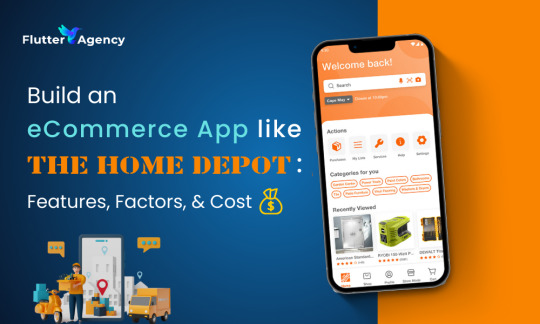
Apps revolutionize home improvements. Homeowners now tap screens for repairs, materials, and DIY guidance. On-demand services surge, connecting residents with pros instantly. Digital platforms streamline projects, from minor fixes to major renovations. This tech-driven shift transforms how we maintain and upgrade our living spaces.
A rising market beckons innovators. Developers now face a prime chance to build an all-encompassing platform—a digital Home Depot for the tech world. This one-stop solution could revolutionize how we access and integrate diverse technologies.
Building an app similar to Home Depot can be highly profitable.
From renovation inspiration to expert guidance, your app transforms home improvement. Users instantly access a vast product selection, professional advice, and essential services. It’s the all-in-one solution for DIY enthusiasts and homeowners alike, delivering tools, ideas, and assistance with a tap. This digital hub streamlines projects, making home enhancement effortless and accessible.
Step-by-Step Process to Build an On-Demand Home Service App like Home Depot
Step 1: First, pinpoint your audience. Homeowners seeking repairs? Contractors hunting supplies? DIY enthusiasts planning projects? Know their needs. Then, dive deep into market research. This crucial step shapes your app’s features. Don’t rush development. Instead, invest time in understanding your users. Their desires will guide your creation, leading to a product that resonates with a profound impact. Remember, thorough preparation paves the way for success in the competitive app landscape.
Analyze Home Depot, Lowe’s, and TaskRabbit’s platforms to identify market openings. Learn from their strengths and sidestep their flaws. Tailor your app with unique features through custom development. By filling gaps and surpassing user needs, your product will stand out in a crowded field, securing its own distinctive space in the market.
Feature List
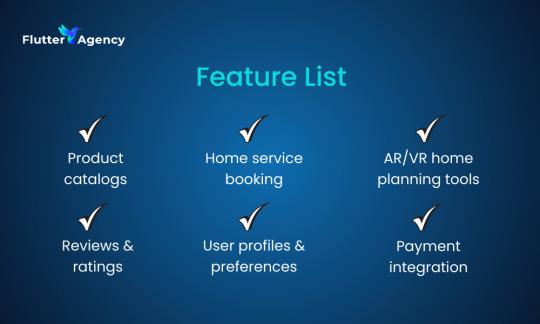
Product catalogs: From power tools to plumbing fixtures, our store stocks everything for your home projects. Browse aisles filled with quality building materials and essential hardware. Find the perfect items to renovate, repair, or upgrade any space in your house.
On-demand booking for home services: Book skilled pros for plumbing, painting, electrical jobs, and beyond. Our platform connects you with vetted experts, making home services hassle-free.
AR/VR tools for home planning (optional): Visualize renovations virtually before committing. This tool lets homeowners preview improvements, aiding confident decisions on home upgrades. See your space transformed digitally, ensuring satisfaction before investing time and money.
User profiles and preferences: Store user preferences and purchase history to tailor their experience. This personal touch enhances engagement and satisfaction.
Payment gateways: Ensure secure and seamless transactions through various payment options.
Customer reviews and ratings: Let users share and explore honest feedback. Reviews build confidence in products and services while fostering community trust.
Custom-built features elevate your app, transforming it into a home improvement must-have. Your platform transforms into an irresistible renovation powerhouse, fueled by top-tier development expertise. Users flock to this ultimate solution, revolutionizing their projects with ease and efficiency.
Step 2: Define the Core Features of the App
A stellar home service app mirrors Home Depot’s core strengths. It seamlessly guides users through tasks, enhancing their experience at every turn. Key elements include intuitive navigation, robust search functions, and detailed product catalogs.
These features, working in harmony, create an efficient, user-centric digital ecosystem for home improvement needs.
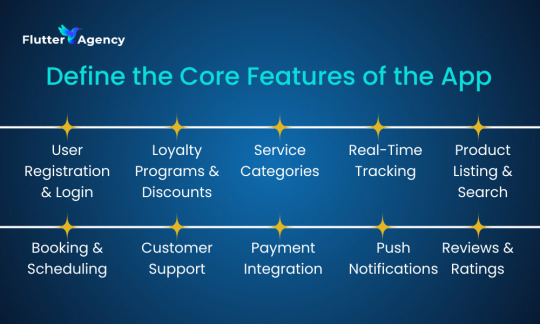
User Registration & Authentication: Social, email, or phone signups streamline user access. Quick logins enable effortless account creation and smooth entry to the platform.
Service Categories: Group services by type: electrical, plumbing, HVAC, and beyond. This streamlined approach helps users quickly locate their desired assistance.
Product Listing & Search Functionality: Users can quickly locate ideal products through our expansive database. Intuitive search filters for price, ratings, and relevance streamline the shopping experience, ensuring efficient and satisfying item discovery.
Booking & Scheduling: Book services and appointments effortlessly with our user-friendly system. Seamlessly integrated calendars streamline scheduling, ensuring maximum convenience for all users. This intuitive platform simplifies the entire booking process, saving time and reducing hassle.
Real-Time Tracking: Track deliveries and services in real-time. Keep users informed every step of the way. Instant updates ensure peace of mind and build trust.
Payment Gateway: Safeguard transactions with diverse payment methods. Accept credit cards, mobile wallets, and PayPal to ensure smooth, secure processing for all customers.
Reviews & Ratings: Feedback fuels progress. Ratings build credibility. By embracing user input, custom app development services evolve. Unlock these tools to elevate quality and earn trust. Continuous improvement thrives on customer voices.
Push Notifications: Keep users hooked with quick pings. Flash enticing deals, track shipments, and nudge about services. Timely notifications foster engagement and spark action.
Customer Support: Chatbots and live agents offer seamless support access. Integrate these tools directly into your platform for swift user assistance. This user-friendly approach enhances satisfaction and resolves issues efficiently.
Loyalty Programs & Discounts: Incentivize loyal patrons through exclusive deals, price cuts, and reward points, fostering return visits and sustained engagement.
For a polished cross-platform solution, consider enlisting Flutter experts. Skilled developers transform app features into captivating experiences, delighting users with seamless interactions across all devices.
Step 3: Design the User Interface (UI/UX)
Crafting a smooth, captivating interface is key to an app’s triumph. For Home Depot’s digital platform, this means seamlessly blending services and products into a user-friendly design that hooks customers and drives success. Here’s how to approach the design phase:
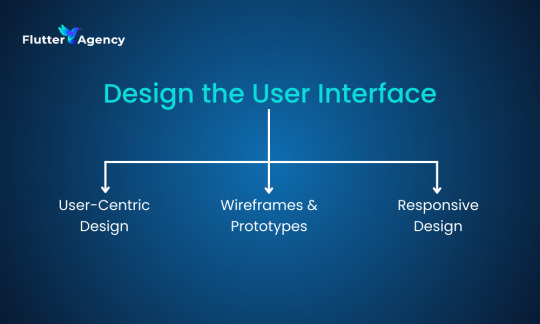
User-Centric Design: Simplicity guides our app’s design. Users navigate swiftly to products, services, and expert advice. Intuitive interfaces ensure effortless exploration for all. Newcomers and veterans alike find efficiency at their fingertips. The digital landscape unfolds seamlessly, prioritizing ease of use. User-friendly elements reign supreme, creating a fluid experience throughout.
Wireframes & Prototypes: Map key user flows with wireframes. Visualize the home screen, product search, and service booking. Prototypes reveal the user’s path, highlighting crucial features. This approach ensures easy access to essential elements throughout the journey.
Responsive Design: From smartphones to desktops, our app adapts seamlessly. It delivers a uniform experience across devices, adjusting to various screen sizes with precision. Users enjoy flawless functionality whether they’re swiping on tablets or clicking on laptops. This versatility ensures everyone can access and navigate the app effortlessly, regardless of their preferred platform.
A sleek, intuitive interface rivals industry giants, drawing users in and keeping them engaged. Your app’s seamless design becomes its competitive edge, fostering customer loyalty and market share growth.
Also Read: How? Develop On-Demand Delivery App For Your Business
Step 4: Develop the App (Front-End & Back-End)
With the design in place, we can now move on to developing the app. Here’s a breakdown of key steps:

Choose a Development Platform: It’s a crucial choice for e-commerce mobile app development. iOS and Android offer platform-specific advantages, while frameworks like Flutter and React Native promise efficiency. With a single codebase, Flutter streamlines development for both platforms, potentially saving time and resources. Weigh your options carefully to align with project goals and team expertise.
Front-End Development: Craft sleek, dynamic interfaces mirroring your wireframes. Polish UI components for swift performance and frictionless user interactions. Prioritize responsiveness and seamless functionality to elevate the overall experience.
Back-End Development: Here’s where the app’s core functionality takes shape. Set up servers, databases, and APIs to power its key features, including:
Service catalog management: Compile and adjust information about services, products, and divisions.
User data storage: Safeguard personal data, preferences, and booking history.
Payment processing: Implement secure payment gateways for transactions.
Admin Dashboard: Develop an admin panel that allows the app’s managers to handle user data, services, orders, payments, and customer support. This helps streamline backend operations and ensures smooth management.
Third-Party Integrations: Integrate external APIs to enhance functionality. These may include:
Geolocation for tracking deliveries and services.
Transaction handling for safe, smooth exchanges.
SMS notifications for timely alerts on service bookings, delivery updates, and promotions.
Merge elegant interface design with powerful server-side capabilities to create an app that flows effortlessly. Hire Flutter mobile app developers, particularly those versed in Flutter, to construct a durable, expandable system. Aim for the polished performance of Home Depot’s app, ensuring user delight and room for future expansion. This strategy paves the way for sustained success and happy customers.
Step 5: Testing & Quality Assurance
Rigorous testing safeguards your app’s quality. Prioritize thorough quality assurance to guarantee users a seamless experience before release. Here’s how to approach it:
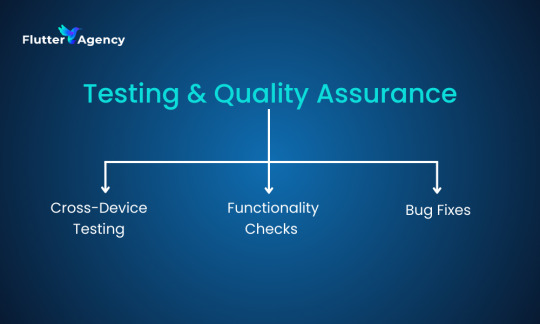
Test Across Devices: From iPhones to Androids, tablets to phones, our app must shine on every screen. We’ll rigorously test across devices, ensuring smooth operation and visual harmony. No matter the OS or display size, users deserve a flawless, unified experience.
Functionality Testing: Rigorously examine the app’s key functions: appointments, transactions, item lookup, and user data handling. Verify seamless operation across all systems. Test thoroughly to catch any bugs or hiccups. Ensure a smooth user experience from start to finish.
Bug Fixes: Bugs uncovered in testing demand swift fixes. Post-launch, attentiveness to user input drives ongoing app refinement. These efforts ensure seamless operation and satisfied users. Vigilance in both phases – pre and post-release – is key to app success.
Step 6: Launch & Marketing
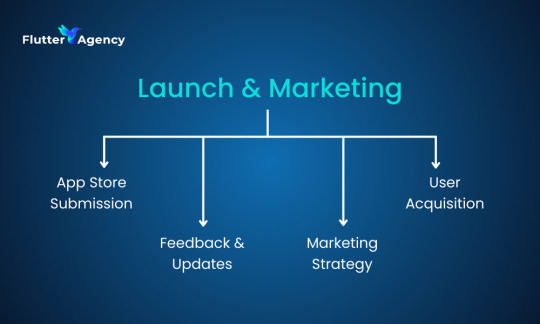
App Store Submission: Launch your app on the Google Play Store and Apple App Store. Follow each platform’s guidelines to avoid delays.
Marketing Strategy: Engage users through a diverse app marketing approach. Start by harnessing social media’s vast audience. Next, forge partnerships with influential voices in your niche. Finally, launch precision-targeted Google Ads campaigns. This three-step approach maximizes visibility, credibility, and user acquisition for your app.
User Acquisition: Create buzz and encourage downloads. Offer discounts to early users. Consider referral programs to help expand your user base.
Feedback and Updates: Regularly collect user feedback to enhance the app. Also, update it often with new features and fixes to keep users engaged and loyal.
By testing and marketing your app, it will work as intended. It will also gain traction in a competitive market.
Cost of Developing an On-Demand Home Service App Like Home Depot
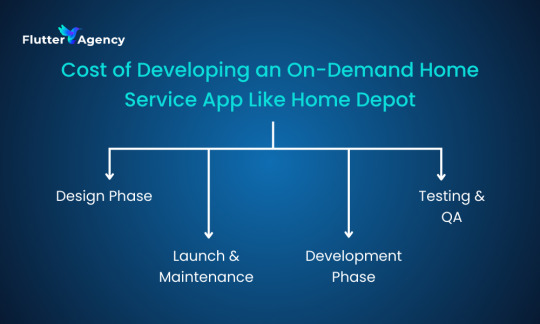
Design Phase
UI/UX Design: $5,000 – $15,000
Wireframing & Prototyping: $2,000 – $5,000
Development Phase
Front-End Development: $15,000 – $40,000
Back-End Development: $20,000 – $60,000
Admin Dashboard: $5,000 – $15,000
API Integrations: $3,000 – $10,000
Testing and QA
Testing: $5,000 – $15,000
Bug Fixes: $2,000 – $7,000
Launch and Post-Launch Maintenance
Marketing & Promotion: $10,000 – $30,000
App Store Submission: $1,000 – $2,000
Maintenance (annually): $10,000 – $30,000
Estimated Total Development Cost: $70,000 – $200,000 (depending on complexity and features)
Final Thoughts
Creating a home service app taps into the growing need for easy home improvements. Similar to Home Depot, you can offer products, services, and expert advice. This approach will attract homeowners, contractors, and DIY fans. Moreover, you can earn money through product sales, service bookings, and ads. This means your growth potential is significant.
Working with custom app developers lets you create apps that meet user needs. This gives you a competitive edge in the growing market. The home improvement sector is growing. Now is the best time to invest in a simple, strong app.
#Build eCommerce App Like The Home Depot#Build The Home Depot Clone App#Custom App Development Services#The Home Depot App Development Cost#Home Service App Development Cost#On-Demand Home Service App#Features of Home Service App#eCommerce App Development Company
0 notes
Text
#cost to build an app like Zepto#grocery delivery app development cost#best grocery delivery app development company#on demand grocery app development company#grocery delivery app development services#Zepto clone app development services
0 notes
Text
Courier Delivery App Development Dubai
#devicebee#appdevelopment#bestappdevelopmentcompanydubai#on demand app development company#appscompanydubai#best app development company#leading app development devicebee#devicebeeuae#ondemandapps#mobile app development dubai#courier delivery app#parcel delivery app dubai#aramex clone app
0 notes
Text

Get a fully customizable white-label food delivery app solution, designed to help businesses of all sizes and offer a seamless online ordering and delivery experience. Our readymade solution is ideal for single or multi-chain restaurants, food outlets, and other businesses which are looking to offer food delivery services. So, what are you waiting for? Launch your own food ordering and delivery platform quickly and efficiently, and start reaching more customers! Contact us today to get a FREE Demo! https://t.ly/iUwsi
1 note
·
View note
Text
Do you want to improve your on-demand delivery services? The best thing you can do is to integrate a GPS tracking system into your app. Read the blog to learn more details!
0 notes